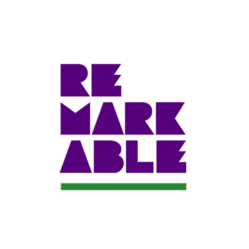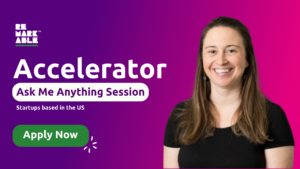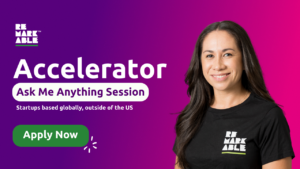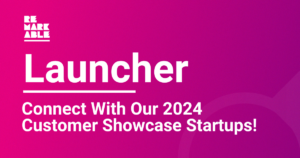Transcript
[0:00] Viv:
We would like to acknowledge the traditional owners of the lands on which we record this podcast, the Gadigal people. This is their land, never ceded, always sacred and pay our respects to the elders past, present and emerging of this place.
[0:17] Viv:
Coming up on Remarkable Insights…
[00:19] Emily:
That has changed the game for me. It’s taken this worry and lack of control out of the environment and given me autonomy and flexibility and really ultimately stopped me having to make a phone call two weeks before I’m travelling.
[00:37] Viv:
This is a podcast about disability driving innovation. I’m your host Viv Mullan and our guest has more stamps in her passport than a pilot. Emily Yates is here to talk about accessibility, design and travel. Emily could you please start by giving a visual description of yourself.
[00:53] Emily:
Sure absolutely. I’m a white woman with bright pink hair and pink glasses that kind of look a little bit like my grandmother’s cook glass, if that makes sense (laughs). And I’m wearing a green tartan jumper and my background is of orange paisley wallpaper.
[01:16] Viv:
And I would love to just get to know a little bit about you and how you got to where you are today with professional and personal setting that you’re in now.
[01:25] Emily:
So I guess the first thing to say that you can’t see on camera is that I’m a wheelchair user and that really is the backdrop to why I’m here today and my career in many ways. So I was born with a condition called cerebral palsy, which you will know all about with the work that you do. And I had an operation when I was nine years old to try and correct certain things that didn’t quite go to plan. So I’ve been a wheelchair user for the last 22 years.
I’m 31 now and it’s quite strange I almost feel that this was part of my identity that I was always supposed to have and it’s led to some really amazing things and opportunities and achievements in my life. I am a really keen traveler. So I’ve gone to lots of different places and experience that accessibility or lack of in those places and that really gave me a bit of a drive to change things, particularly within both the built environment and attitudinal barriers that disabled people often face.
And then career-wise, after finishing university in London I was very fortunate to have an opportunity to volunteer at the London 2012 Olympic and Paralympic games. Really, my work started from here because I was invited by Lord Sebastian Coe who helped organize the games to sit on a press conference, and he quoted me in his closing ceremony speech at the games.
[03:05] Viv:
Wow! You have achieved such an incredible amount and do you remember what the actual quote was?
[03:12] Emily:
Yes, ‘For London and for the UK having the games there had lifted the cloud of limitation for lots of disabled people’.
[03:22] Viv:
Wow, and is that because there really had been a lot of work done to improve the accessibility in the lead up to those games?
[03:28] Emily:
Yes. Firstly, I think that’s a really important point that, it’s sad isn’t it that really has to be the case, that you have to have a huge global event coming to somewhere for change really to be made, but it’s true that had happened. But I think secondly, and just as importantly, this visibility of disabled people and this heightened representation of disabled people had really changed attitudes and perceptions. I remember being around London, finishing my volunteering shift, starting them, and people were just more willing and more confident to communicate and to think about the language that they’re using and just be a little bit more proactive in how they might welcome disabled people into certain environments and that change that I witnessed was really quite, quite a joy to see. And again, it’s a shame that a global event has to make that change, but the longevity hopefully was worth it.
[04:36] Viv:
Wow! You’ve mentioned in there that you’ve got this real passion for travelling, which has taken you to various parts of the world with the work you do. I also know that there’s been quite a large amount of conversation lately about just how inaccessible the experience of travel and air travel can be for people with disabilities, specifically wheelchair users. Can you speak to that, to the conversation that has begun and how you hope to help find solutions with the work that you’re doing?
[05:07] Emily:
Yeah, absolutely. So for me personally, the crux of a lot of issues is that the design doesn’t communicate with the operations. And this is probably no more obvious than in an airport and an airline situation where you’ve got the design of the airport, the design of the plane, both of which have accessible amenities but are inaccessible in other ways.
For example, you can’t yet get your wheelchair on board and stay on board in a plane. But that’s a whole other story. But in between all of these designs, you’ve then got the operations that are wanting you to get through the airport onto the plane. And if that operational value and service doesn’t work through the design that’s present, it’s impossible for disabled people to have an equitable experience because we’re relying on that operation to give us that same potential and value as passengers, as our non-disabled counterparts. So you’ve only got to think about, this doesn’t even relate to getting on the plane itself, but you’ve only got to think about, ‘okay, the commercial value that airports bring, and the fact that we all like to go through duty free and spray a bit of free perfume on and go to some posh shops everybody likes to do that.
Actually with the way that the assistance service is set up at the moment in a lot of airports, unless you are able to completely take yourself through the airport and meet somebody at the gate quite a lot of the time, you’ll be transferred into a bit of an assistance pen once you’ve got through duty free, and then you’ll sit there for an hour and somebody else will come and pick you up to take you to the gate. i.e. You bypass all of that commercial joy and opportunity that everybody else gets to access. And for me that’s because the design and the operations of the airport don’t fit together. And they should, and that’s what we should be working on.
[07:12] Viv:
And what is the role that technology plays when you’re looking at how you can redesign these spaces?
[07:19] Emily:
How a plane’s going to look in the future. What’s that link between the airport and the airplane going to be in the future. That will all have to be technologically redesigned.
How will technology improve our communication between airport, airline, and passenger in the future? That to me is really interesting. Goes back to that design versus operations situation again. How do we make sure that everybody’s informed and everybody has that choice because we’re talking about disabled people and the horrific things that are going on at the moment about mobility equipment being damaged and people being left on planes for hours on end, waiting for assistance and absolutely that is true, and that must be spoken about.
It’s not acceptable, but at the other end of it, when you look at the kind of back of house operational environment, assistant staff are absolutely beside themselves with the amount that they’ve got to do. There is a lack of staffing, there is a lack of training. People in many ways are really trying their best and not getting the support that they need, not having the correct communications.
So that’s another area that I’m really keen to look at and to speak to because we can only improve things for everybody if both of those parts work together.
[08:44] Viv:
Such a good point. And have you got any examples of technology that you’ve helped implement in the airport setting that has improved that experience?
[08:55] Emily:
So this isn’t specific to an airport environment but I think it’s very interesting. So if you think of somebody who is blind or partially sighted and needs to get through an airport, a train station, a museum, whatever it might be. You can have tactile paving on the floor, you can have tactile signage, but the tactile paving only goes so far in the sense that it directs you until you need to make a decision and then you don’t know what decision you need to make and where you need to go.
And then the second part is tactile signage is great as long as you know where to find it and where to put your hand to read it and this is where I think digital accessibility or technology could be really interesting and we need to start looking at it in this way because what if you utilized that tactile paving and it helped you to direct where you were needing to go, but once you had to make a decision, you could do so utilizing that technology.
Or what if you were able to be directed by an app to specific tactile signage that told you a little bit more about where you were, the environment that you were in, the knowledge that you needed to learn to have a great experience, etc. So for me personally, they’re the really exciting opportunities around technology.
[10:28] Viv:
And just in your own personal sort of travel experience, what kind of role does technology play in just your journey throughout it? Do you have any sort of tech hacks?
[10:39] Emily:
One thing that has absolutely changed the game for me, and it’s not an airport specific one, it’s actually a rail app, is an app called ‘Passenger Assist’ that, I don’t know if you’ve heard of.
So it allows me to now, in genuinely about 30 seconds, book a train ticket, reserve my space as a wheelchair user on the train, which I’m unable to do online as it stands right now. Tell somebody exactly what I need, whether it’s help pushing my wheelchair, help carrying luggage. The fact that I need a ramp onto the train and where that assistance should start and stop, both at the start and the end of the journey.
That has changed the game for me. It’s taken this worry and lack of control out of the environment and given me autonomy and flexibility, and really ultimately stopped me having to make a phone call two weeks before I’m travelling, allowed me to be more impulsive with my travel, because let’s face it, who really makes those calls?
There’s been so many times when I’ve not booked assistance when I should because I’ve forgotten to make the call or those kind of things. So this has really helped me become more independent and autonomous but I can see for companies and staff members how it’s also massively helped them as well because there’s no excuse now not to just say this is what I need, this is where I’ll be and this is how you can help me. So that has really changed the game for me. Such a simple system, such a simple process, but it shows just how those simple things are often the best.
[12:29] Viv:
Yeah. And I know that things are being used like VR headsets and digital tours of ways we can change a physical setting. Have you ever engaged any sort of technology like that?
[12:40] Emily:
Absolutely. So we have been looking at what the design of train stations might be in 10-15 years from now, when these stations open. What’s really fascinating is we’ve been able to put together an experience for both disabled and non-disabled people to go through, and they’re really able to experience what that train station would look and feel like.
What it is meant in terms of our particular work is that they’ve been able to work out, ‘right okay, that sign should be placed there because that’s where people are looking and this is where they stop in order to make a decision about where they might want to go next.’ ‘This colour works really well, this signage height works really well, the tech should be this big, etc. etc.’ And what it has also meant from an accessibility point of view is we’ve been able to take disabled people through that VR environment and they’ve been able to say ‘right okay, I would want to be making a decision here, I would start to feel quite anxious here if I’d not seen a member of staff yet’, or if I’d not had an opportunity to confirm where I needed to go at this point’, ‘actually, I would like to know that I need to get to the step free access route at this point’, and it just has really allowed us with customers and those with lived experience at the heart of the design to really think about exactly where we’re going to place different elements of that design so they can be as human centred and customer-centric as possible.
[14:25] Viv:
Such a good point, and we’d like to end these conversations by asking our lovely guests to leave listeners and people enjoying the show with a remarkable insight, which could be a piece of advice, your favourite quote, anything that you would like them to think about after this episode.
[14:42] Emily:
One of the best phrases I ever heard it was from the CEO of Enhance the UK, a disability awareness charity I used to work for. One thing that they teach in their training sessions is ‘there’s no such thing as disabled and non-disabled people. Only disabled and not yet disabled people, and actually accessibility and inclusivity and equitable experiences can and will benefit everybody’.





